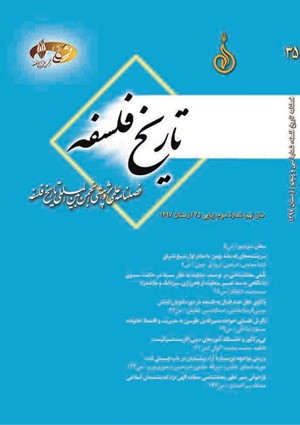كييركگور و خاستگاه آموزه¬هاي ديني اگزيستانسياليست
محورهای موضوعی : ریشهشناسی مکاتب و آراء فلسفی در ادوار قدیم و جدید
1 - دانشگاه آزاد اسلامي
2 - دانشگاه ازاد اسلامی واحد تهران مرکزی
کلید واژه: آموزه¬, هاي ديني كييركگور جهش شورمندي اگزيستانسياليسم ,
چکیده مقاله :
نوشتار حاضر در پي تبيين نگرش كييركگور، فيلسوف برجسته آغازگر اگزيستانسياليست، نسبت به آموزههاي ديني است. كييركگور سه ساحت استحساني، اخلاقي و ايماني را براي انسان در نظر ميگيرد که از مرحله استحساني تا مرحله ايمان، فاصله زيادي وجود دارد و از همينروست که وي براي تبيين سير در اين ساحات، واژههايي همچون «شورمندي» و «جهش» را بکار ميبرد. ديالکتيک ناپيوسته کييرکگور در گذر از مرحلهيي به مرحله ديگر نشان ميدهد که اولاً اين سپهرهاي سه گانه هرگز قابل جمع با يکديگر نيستند؛ حتي اگر براي مدتي در کنار هم باشند، سرانجام زماني فراميرسد که ناگزير يکي را بايد انتخاب نمود. ثانياً نحوه گذر از بين اين مراحل منطقي و چارچوب مند نيست. کي يرکگور وقتي با مسئله ايمان ديني روبرو ميشود، ديگر جايي براي عقل و انديشه باقي نميگذارد. بعبارتي، وي زمان و مکان و راه روشني را مشخص نميکند تا انسان بداند که در چه زمان و مکاني ميتواند به مرحله ديگر برسد، بلکه به اعتقاد وي در اين راه بايد خطر کرد، معجزه آفريد و بدون عقل اين مسير را پيمود. اين خطر کردن، سبب جهش از مرحله اخلاقي به مرحله ايماني ميگردد که بالاترين مرحله زندگي اصيل يا اگزيستانس است؛ جهشي که از چارچوب قواعد عقلي بيرون است و از اينرو فهميدني نيست. تمامي تلاش كييركگور در آثارش بر اين است که نشان دهد دو حوزه ايمان و عقل کاملاً با يکديگر متفاوت و بلکه متقابلند و ازاينرو نبايد مفاهيم حوزه ايمان را با معيار عقل سنجيد.
The present paper explains the view of Kierkegaard, the prominent founding philosopher of existentialism, regarding religious teachings. Kierkegaard refers to three aesthetic, ethical, and religious spheres for human beings and maintains that there is a large distance between the aesthetic and religious stages. Accordingly, in order to explain the process of development in these spheres, he uses such words as “pathos” and “leap of faith”. Kierkegaard’s discontinuous dialectics, when moving from one stage to the other, reveals that, firstly, these three-fold spheres can never unite with each other even if they co-exist for some time. Finally, there comes a time when, inevitably, one has to be chosen. Secondly, the quality of moving from one stage to the other is not logical and cannot be explained within a specific framework. When confronting the problem of religious faith, Kierkegaard does not allocate any place to the intellect and thought. In other words, he does not specify a certain time, place, and method so that individuals know when, where, and how they can reach the next stage. Rather, he believes that one must take risks in this process, do miracles, and follow the way without resorting to the intellect. Such risks cause a leap from the ethical sphere to the religious sphere, which is the highest level of an original life or existence; a leap which does not fit the framework of rational principles and, hence, cannot be perceived. Kierkegaard dedicates all his efforts in his works to demonstrating that the two spheres of religious belief and intellect are not only different but also in contrast to each other and, thus, one cannot evaluate religious concepts against the criterion of the intellect.
